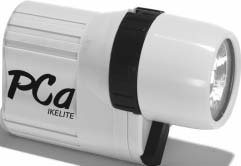Lighten UpContents of this Issue: Men Not Seeking Women; Women Not Seeking Men Editorial Office: Ben Davison Publisher and Editor Undercurrent 3020 Bridgeway, Suite 102 Sausalito, CA 94965 The better to see it with from the July, 1997 issue of Undercurrent
Deciding which dive light to buy isn't easy. Among the choices you're faced with, the strongest is 1,000 times as bright as the least powerful -- but some have a very tight beam, others have a broad halo, and their sizes range from one that can dangle on a key chain to powerful strap-onyour- waist technical lights. Here are some tips from tests conducted by Steve Weinman, managing editor of Diver magazine, published in the United Kingdom. He compared several lights in four categories -- lanterns, hand lights, mini lights, and technical lights. As a rule, he found that rechargeable lights provided more light than their dry-cell-equipped counterparts, but always at the expense of burn time. The following is a condensation of his study, which originally appeared in Diver. Lanterns Bigger and heavier lanterns are the choice of serious night divers, though their bulk may be too much for traveling divers. Out of a group of four very similar competitors (Underwater Kinetics' UK400R, Princeton Tec's 400R, Ikelite's RCD Rechargeable, and Technisub's Vega 2), the UK400R has the edge in light output. Out of all of the lights tested, the UK800R and Princeton Tec 8000R lanterns have the brightest hot spots. The first has a wider spot, but the second probably offers better long-term watertightness. The Subatec SB80 Pro has the widest beam of any light, producing no hot spot at all when adjusted to its wide setting. The Beuchat 50W Lantern, with its rubber-covered pistol grip, handles well in the water and gives a bright and reasonably wide hot spot; it has one of the widest haloes of all the lamps tested. The patchy beam of the Pelican BriteLite disappointed testers.
Considering price and performance, the UK800R and Princeton Tec 8000R were our first choices, closely followed by the smaller UK400R, Tec 4000R, and Ikelite RCD rechargeable. The Ikelite RCD is best in the dry-cell category, and the Mares Arturo 12 and Subatec SB80 Pro are good choices for those with cash to spare. Hand Lights Traveling divers who carry their lights usually prefer hand lights, which are usually compact enough to fit into BC pockets. The performance stars in this category are the Ikelite PC Lite, Princeton Tec 600, and Underwater Kinetics SL6. Smaller versions, using four instead of six C batteries, are the Tec 400 and UK SL4. These do not necessarily give less light, but usually throw a narrower beam and provide less burn time. Both have a switching arrangement as simple as that of their larger relatives. The anatomically similarly Scubapro Pocket Light gives a narrower, brighter beam. The Technisub Quartz Mk2 produces a reasonable amount of light from eight AA batteries for a whopping nine hours and has proved particularly watertight. However, our choice for best all-round performer was the Ikelite PCa. A smaller version of the Ikelite PC, this produces a broader beam, is very bright for its class, fits easily into any BC pocket, and gives a very respectable burn time from six AA dry cells. Another Ikelite, the Super C Lite HR, is too large to fit into a BC pocket. The Ikelite Mini C Lite, a reducedscale version that uses four C cells, is comparatively puny in performance. Mini Lights It is comforting, when all else has failed, to be able to pull a tiny backup torch from the recesses of your BC. If you find yourself floating alone on the surface of the sea at night, a tiny backup torch could save your life. By far the best performer in this class is the Underwater Kinetics UK Mini Q20 (with handy karabiner clip). Its two lithium batteries provide a high output in one of the smallest packages. It's also the most expensive. The Scubapro Krypton Mini, Princeton Tec 20, and Pelican MityLite also performed well. The MityLite is designed like a penlight and comes with a useful, fiber-optic-style attachment for inspecting the interior of your diving cylinder and other awkward corners. So does the Pelican Super MityLite, with 50 percent more battery power and 50 percent more brightness. Then there's Pelican's Super Duper MityLite, which, oddly enough, gave less impressive results than its Super. With a couple of notable exceptions, all the little lamps mentioned here use AA batteries. All give long burn times, though not very brightly. Technical Lights For overall performance and total manufacturing quality, the laurels go to the MetalSub products from the Netherlands. These are built with the precision one might expect of a modern military weapon. The MetalSub KL12170, with two hours of useful burn time, gave the brightest hot spot of all the technical lights we tested. The cheaper MetalSub K1255 comes with a less powerful ni-cad battery for less burn time and a small hot spot. Both have large peripheral haloes. |

I want to get all the stories! Tell me how I can become an Undercurrent Online Member and get online access to all the articles of Undercurrent as well as thousands of first hand reports on dive operations world-wide
| Home | Online Members Area | My Account |
Login
|
Join
|
| Travel Index |
Dive Resort & Liveaboard Reviews
|
Featured Reports
|
Recent
Issues
|
Back Issues
|
|
Dive Gear
Index
|
Health/Safety Index
|
Environment & Misc.
Index
|
Seasonal Planner
|
Blogs
|
Free Articles
|
Book Picks
|
News
|
|
Special Offers
|
RSS
|
FAQ
|
About Us
|
Contact Us
|
Links
|
3020 Bridgeway, Ste 102, Sausalito, Ca 94965
All rights reserved.


